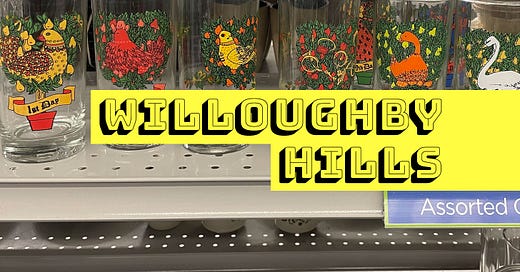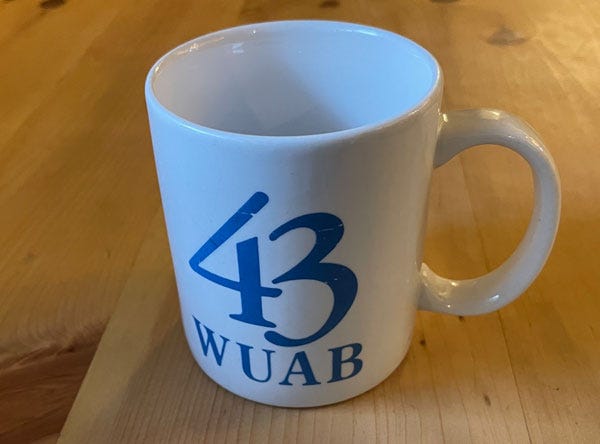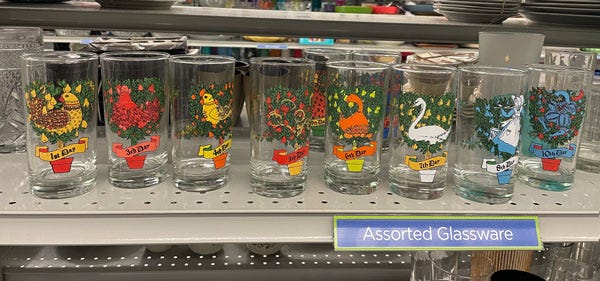Dead People's Stuff
Getting comfortable with thrift stores selling the last remnant's of people's lives.
Welcome to another edition of Willoughby Hills!
This newsletter explores topics like history, culture, work, urbanism, transportation, travel, agriculture, self-sufficiency, and more.
If you like what you’re reading, you can sign up for a free subscription to have this newsletter delivered to your inbox every Wednesday and Sunday and get my latest podcast episodes:
It wasn’t all that long ago that I had an aversion to used things. At least part of it was informed by the times in which I was raised, when the impression was that there was plenty. Advertising and popular culture spread the message that newer is better, and my family had enough socioeconomic standing to indulge that programming.

After the terrorist attacks on September 11, 2001, President Bush urged Americans to stave off a recession by buying more, saying “Get down to Disney World in Florida… Take your families and enjoy life, the way we want it to be enjoyed." Newer was better and older was, well, old.
My dislike of used items wasn’t just about cultural pressures though. Some of it was more personal, and perhaps irrational. It may sound strange, but I didn’t like the feeling of owning and using something that once belonged to a dead person. I would happily buy items from a “garage sale” or a “yard sale,” but call the same event selling the exact same items an “estate sale” and I was not interested.
When I was about 10 years old, an old lady in our neighborhood died who was a hoarder. This was long before the concept of hoarding was commonplace. In fact, we didn’t even know how to describe her, other than to say she had a lot of stuff.
Her house was an old Victorian with two eyebrow windows and a giant porch. That was scary enough. But the inside was loaded to the ceiling with everything imaginable. She had a car parked in her garage that was no longer drivable because the seats were all piled high with items.
Her estate sale became a neighborhood event. It was a chance to score some deals on funky vintage things, but to also get a look at the inside of this mysterious house. I bought an antique wash board and placed it in my room as decoration. I couldn’t sleep that night because I was too freaked out by the washboard having belonged to the now deceased hoarder. I think my parents had to move it to the basement after that.

I would still shop at thrift stores on occasion, but I felt like I could tell what had been donated by a living person who no longer had use for it and what was part of an estate cleanup.
My mind began to change about dead people’s things when my wife and I visited Hawaii in 2008. She had spent a few years there during her childhood and wanted to show me her old stomping grounds. We stayed with an older woman who had befriended my wife’s mom when they all lived in Hawaii.
The woman was recently widowed and was happy to have us as company. She let us do our thing all day, but we would visit with her in the evenings. At the end of the trip, she gave me a half dozen or so Aloha shirts that had belonged to her husband. I was freaked out, but I also felt like we had made a connection and that there was something in me that reminded her of her late husband. I could feel the immediacy of her loss, and saw that her gifting me his old shirts was both a practical matter of cleaning out the house and an emotional one, giving new life to something after losing so much.
After that, I wore those Aloha shirts everywhere. They became a favorite part of my wardrobe. They weren't the cheap polyester kind that were sold at tourist stands, but were expensive and high quality, sold by the local department store where Hawaiian people shopped. I’ve had those shirts in my closet for 15 years now, and even though I don’t wear them as often now, I have a hard time donating them, not knowing whether they will end up in a loving home or sent to a landfill.
The Aloha shirts helped me get more comfortable with dead people’s clothes, but I still struggled for a long time with using any kind of dishware that might have belonged to a dead person.
Getting over that fear started with coffee mugs. When I was visiting Cleveland one time after I had moved away, I stopped into a thrift store and found a cool old ceramic mug for WUAB, which was the independent TV broadcast station in Cleveland (it later became a UPN affiliate and is today a CW network). I loved the mug, but I had to run it through about 10 dishwasher cycles before I was comfortable using it, and even then it still took some getting used to before it became a regular part of my kitchen.
Years later, as I was drinking from that mug, I was thinking about my aversion to other people’s stuff and why I had a hard time latching on and making it my own. Out of the blue it clicked for me that I was being irrational.
I thought about my expectations in a nice restaurant. I would be served water, coffee, or wine and would drink from their vessels without a straw. I didn’t even give it a second thought. The forks and spoons that I use in a restaurant similarly touch hundreds of patrons’ mouths and I am completely comfortable using them just the same. I would never expect to eat a restaurant steak on a paper plate with plastic cutlery.
Why am I so uncomfortable with the thought of using something that came from one person’s house, where it was maybe used by five or six people in its lifetime, but I wouldn’t hesitate to use an item that had been used hundreds of times in a restaurant? Surely some of the people that used the same cup or fork as me in a restaurant had since passed. None of it was logical, and for some reason framing it in that new way unlocked everything in my mind.
Beyond that, around the same time my three living grandparents all died in quick succession. My grandpa in particular had a lot of hobbies, from gardening to painting to playing music to photography. He had acquired all kinds of tools and supplies for his hobbies over the years and I wanted to think that his passions could be spread to others through his possessions after he was gone.
It was the same comfort that our Hawaiian host felt in gifting me her husband’s clothing. We want our loved one’s lives to have meant something and maybe part of that is wanting their objects to find a good new home.
When it was time to replace our daily use dinnerware, my wife and I originally had planned to go somewhere like Macy’s and buy a matching set of some kind. But the quality of newer plate sets was quite low and we decided to be on the lookout for interesting vintage sets at thrift stores.
I shared in the newsletter last year that we were lucky enough to find a huge lot of matching plates, bowls, and coffee mugs. There were more than 100 pieces selling at my local Savers thrift store, and we scored the entire lot for $36!
It’s a design known as the Old Curiosity Shop, based on a Charles Dickens novel. The pieces depict life in Victorian England. According to one source, they were made by the Royal China Company in Sebring, Ohio in the 1950s and would have been sold at department stores and grocers like A&P in quantities of like items (a box of four plates, for example) rather than as a single complete set.
Given the amount of pieces and their age, I can only imagine that they had come from somebody’s estate after they passed- perhaps a collector or even former salesperson who had extra samples around (because seriously, who has 100+ items from a single set?!) An estate clean out is the only logical explanation for why so much dinnerware in such good condition would wind up at a Savers store. The plates and bowls are all sturdy and solid. They were made in America 70 or so years ago and are still going strong. I was comfortable eating off of them after a single dishwasher cycle, thinking of the way restaurant plates are washed.
A few months later, we were in a 2nd Avenue thrift store in Pennsylvania (a mid-Atlantic variation of Savers) and found a really cool vintage glassware set depicting scenes from the 12 Days of Christmas. On one side is the words of each verse of the song and on the other is beautiful artwork depicting that verse and its gift.
There’s an abundance of these glasses selling on eBay and Etsy, but there’s scant information about them online. According to one source, they were made in Indiana by the Indiana Glass Company and could have been sold at K-Mart. There are similar (though not exact) glasses still in the box for sale on eBay under the names Glassware by Brockway, Anchor Hocking, and Glassware by Jeanette so perhaps this style was once ubiquitous.
At any rate, we were able to score a mostly full set (it was missing two glasses) for about $20. By that point, my aversion to used things had completely faded. We hand wash these glasses out of fear that the artwork might peel off in the dishwasher, and I started drinking from them as soon as we got them home.
I expected them to be a seasonal treat that we bring out each December, but our kids fell in love with the vintage cups too, and now they are our daily drinking glasses.
These days, I have a very different feeling about used items. I now see the character, charm, and quality in older things that simply isn’t there in newer ones. Maybe I’m less superstitious than I used to be, but I have no issue wearing clothes, drinking from glasses, or using tools that once belonged to somebody else.
To some extent, I think this is a recognition that “they don’t make things like they used to.” Older items seem to be of a much higher build quality than what’s available today. They also take on a uniqueness that is tough to find in current mass produced items (even though the vintage items were also mass produced in their day).
Another part of my shift is the acceptance of my own mortality and the mortality of those around me. Realistically, I realize that we acquire and retain a lot of objects in our lifetimes, and it’s a wasteful thought to imagine all of the material possessions of a person should end up in a landfill. Anything that is still useful is valuable and should be passed along to others and continue to be used.
In that way, none of our stuff really is ours anyways. We can’t take it with us when we go and we will rarely reap the financial benefits of the sale of our most valuable items (although our heirs might). We spend a lifetime collecting things and in an instant, those things are released back to the world, ready for a new owner and a new life.
I’ve learned to embrace and appreciate this collective view of our stuff and it’s started to change how I view land, water, and all of the other parts of this world that we think belong to individuals even though they never truly can.
Thanks for reading Willoughby Hills! Subscribe for free to receive new posts and support my work.
Related Reading
What Does It Mean to be "Old"?
If you’ve missed past issues of this newsletter, they are available to read here.










Thanks for another enjoyable article Heath! I love the way you think and write.
Your old friend and neighbor,
Becky Vergara